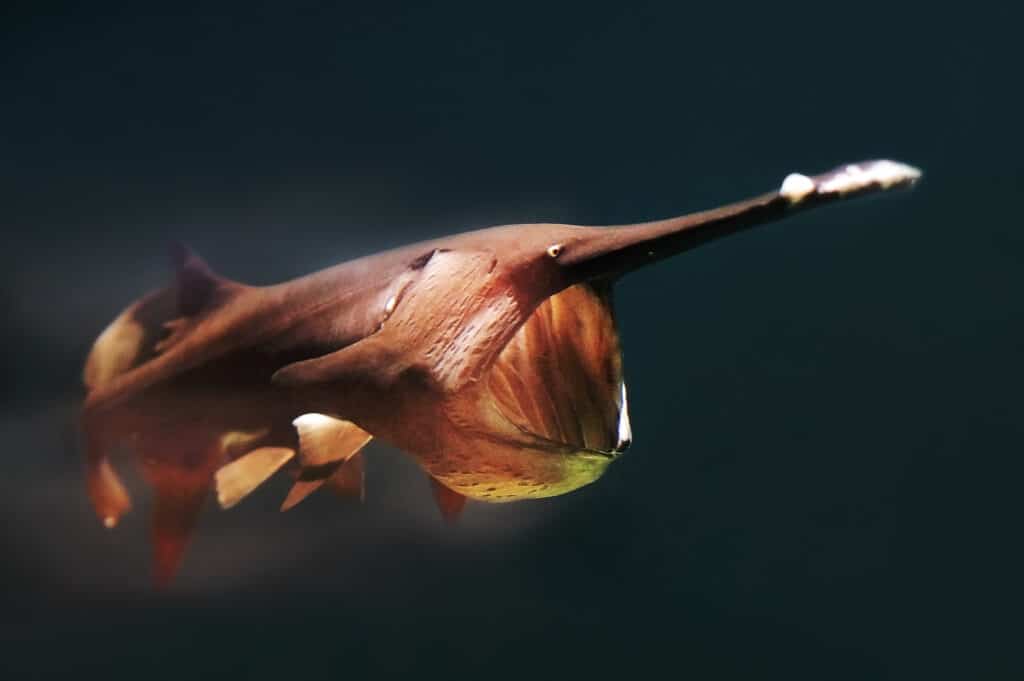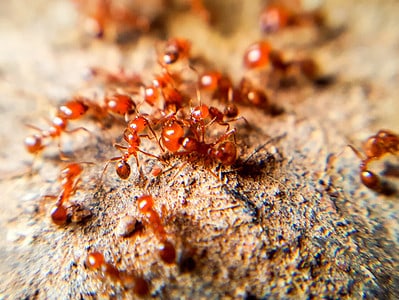American Paddlefish
Polyodon spathula
Advertisement
American Paddlefish Scientific Classification
- Kingdom
- Animalia
- Phylum
- Chordata
- Class
- Actinopterygii
- Order
- Acipenseriformes
- Family
- Polyodontidae
- Genus
- Polyodon
- Scientific Name
- Polyodon spathula
Read our Complete Guide to Classification of Animals.
American Paddlefish Conservation Status
American Paddlefish Facts
- Habitat
- Currently, these fish are only found in the Mississippi River Basin.
- Diet for this Fish
- Zooplanktons
American Paddlefish Physical Characteristics
- Skin Type
- Smooth
View all of the American Paddlefish images!
The American Paddlefish is also regularly called the Mississippi Paddlefish. While this may seem confusing, this species is the only living animal in the Paddlefish family. Therefore, all Paddlefish common names refer to this species.
This fish is closely related to Sturgeons. However, the species is quite old, with fossils dating back to 125 million years.
5 American Paddlefish Facts
- Primitive: This species is referred to as a “primitive fish,” which means that it likely resembles very early fish ancestors.
- Shark Fins: While this fish is not closely related to the shark, it has a caudal fin that resembles a shark fin. Therefore, they are sometimes referred to as freshwater sharks.
- Specialized Eating: This fish is very unique thanks to its filter-feeding system. Its large “paddle” has thousands of sensory receptors that detect zooplankton, which is its primary food source.
- Only Surviving Paddlefish: The American Paddlefish is the only known surviving member of the paddlefish family. The Chinese Paddlefish is thought to have gone extinct in 2003.
- Shrinking Range: The species does have a shrinking range. Today, they live primarily in the Mississippi Basin. However, they were once found all the way into Canada.
American Paddlefish Classification and Scientific Name
The American Paddlefish is part of the polyodotidae family, also referred to as the paddlefish family. This species is the only known species in this family that is still alive today. The only other species to survive into modern times was the Chinese Paddlefish, but that species went extinct in 2003.
They are in the same order as sturgeons and similar fish. These species are the closest-related relatives of the paddlefish, as their family is extremely small. While this fish may be referred to as a freshwater shark, they are not actually closely related to sharks.
The American Paddlefish also belongs to the Actinopterygii class, which contains about 50% of known vertebrates. The fish in this class are referred to as ray-finned fish and are likely very ancient.
American Paddlefish Appearance
The American Paddlefish is referred to as a primitive fish species, as it shares many traits with extremely early species. Therefore, it resembles how fish likely looked when they first evolved.
The average American Paddlefish is around 4.9 ft long and weighs 60 pounds. They are commonly referred to as “shark-like.” However, they are not dangerous and do not eat meat.
Like Sturgeon, the American Paddlefish is smooth-skinned and almost entirely made of cartilage. Their eyes are relatively small and their vision isn’t the best, indicating that they don’t rely on sight much at all. They do have large gills and a large mouth, which they use to filter zooplankton. They also have a rostrum like a shark that measures about 1/3 of their body length.
This fish does not have a rostrum early in development, however. The upper fin doesn’t develop until after the fish hatches. However, it does begin to form pretty quickly after hatching. This fin is an extension of the skull.
Usually, these fish have rather dull colorations. They range from bluish to black with a white underbelly. Their coloration can vary, but they are never brightly colored.

American Paddlefish use their large gills and mouths to capture zooplankton.
©Marina Veder/Shutterstock.com
American Paddlefish Distribution, Population, and Habitat
Unlike many freshwater fish, the American Paddlefish is extremely mobile. Therefore, their population in certain areas can vary as fish move about. They inhabit many rivers in the Mississippi Valley and Gulf slope drainages that attach to the region. Usually, they are found in deeper, low current areas, such as side channels, lakes, and tailwaters below dams.
Because these fish are not strong swimmers, they prefer to stay away from the current, when possible. However, when they need to move, they will. They have been found to move over 2,000 miles within a river.
Currently, these fish are only found in the Mississippi River Basin currently. However, there are good odds that the fish once had a larger range. Historically, they would have been found in Missouri and Yellowstone rivers, as well. However, their range has shrunk over the last few years. Therefore, they are mostly found further south today.
They were driven out of New York, Maryland, and Pennsylvania historically. Furthermore, they are not commonly found in the Great Lakes region anymore, though they once enjoyed an extensive range there. In some cases, states have tried to reintroduce the fish in certain rivers, typically via hatchery programs.
There is some evidence of fish being caught in the Great Lakes region and sometimes being plentiful. However, researchers have been unable to find evidence of natural reproduction, which would be needed to maintain a population. In 2019, the IUCN Red List listed Polyodon spathula as Vulnerable.
American Paddlefish Predators and Prey
Because American Paddlefish are so large, they tend not to be eaten by other fish or other predators.
What Does the American Paddlefish Eat?
The American Paddlefish has a relatively unique feeding system. Their rostrum is covered in millions of sensory receptors. These receptors are similar to those of sharks and rays. However, the Paddlefish uses them to detect plankton, its main food source. Furthermore, they also have clusters of electroreceptors along the rest of their body.
Primarily, it is thought that this fish detects electrical fields that are generated by zooplankton. This fish can also detect the movement and feeding of these zooplanktons. When they detect these small planktons, the Paddlefish will swim forward with its mouth open, allowing the gill rakes to filter out the plankton.
These fish have extremely underdeveloped eyes. Therefore, they cannot respond to changes in light, such as shadows. Their electroreception largely replaced their vision, however.
American Paddlefish Reproduction and Lifespan
In the proper environment, these fish can live for as long as 30 years. However, the median age of this species is around five to eight years. Most fish do not live their whole lifespan. Usually, the maximum age in the wild is around fourteen to eighteen years. Ages are determined through dentary studies.
Studies have found that some individuals can live as long as 60 years. Typically, females live longer and grow bigger than males.
These fish also mature late, likely because of their longer lifespan. Usually, females do not begin spawning until around 7 to 10 years old. However, some reports found that some females do not spawn until closer to 16 or 18, near the end of their lifespan.
Furthermore, females do not spawn every year. Instead, they typically spawn every other year or every three years. Males do breed much more often, though. However, males also do not reach maturity until 7 years, though some may not spawn until much later.
Usually, this fish will travel upstream in the early spring to spawn. However, some of them travel in late fall, instead. Scientists are unsure why some fish travel at different times. This fish spawns in gravel bars, where the area will be exposed to air or only covered by very shallow water. However, when the spring snowmelt occurs, more water is found in these areas.
These fish only spawn if very specific events occur, as well as having a proper place to spawn. Firstly, the temperature between be between 55 to 60 F. Secondly, the days must length significantly enough to let the fish know that it is springtime. Thirdly, there must be enough rise in the river to allow for breeding.
These environmental conditions are only met every four to five years. Therefore, the average area will only see paddlefish spawning every few years – not every year like some other fish. When these fish do spawn, though, they produce a lot of hatchlings. They are broadcast spawners, which means that females will release their eggs in the proper location at the same time the males release their sperm.
After they are released, the eggs become sticky, which allows them to stick to the gravel. The eggs take about seven days to develop, depending on the water temperature. After hatching, the fish drift downstream to an area with very little current.
Because these fish are poor swimmers, they are very susceptible to predation. Therefore, they grow very fast to prevent being eaten. In fact, fry grow by about an inch a week. However, growth is dependent on the amount of food available.
American Paddlefish in Fishing and Cooking
Paddlefish is not typically eaten by humans, though it isn’t poisonous or toxic. However, their eggs are occasionally used for caviar. American Paddlefish are currently being raised throughout Europe and even in Russia, where the fish is kept largely for its eggs.
In America, the fish is largely utilized for sports fishing. Where their population is large enough to allow for these activities, they are quite popular. Often, in areas without active breeding populations, lakes and ponds are stocked to maintain fishing. Because these fish are filter-feeders, they must be caught by snagging.
View all 194 animals that start with AAmerican Paddlefish FAQs (Frequently Asked Questions)
Are American Paddlefish rare?
For the most part, it depends on where you are. There are some states where this fish thrives and is pretty easy to catch. In other states, the fish comes and goes depending on migration patterns. These fish move a lot, so it isn’t odd for their populations to vary. In some areas, fisheries rely on the state to stock the fish.
Are American Paddlefish endangered?
Technically, this fish is listed as vulnerable. In some states, it is extremely common. However, in other states, it is extinct. Its range has decreased over the years, so its population is shrinking – not growing.
Can you eat American Paddlefish?
Typically, this isn’t a fish that you commonly see on menus. However, they do taste great, and some fishers do eat them. Still, you’ll likely have to catch them yourself, as they are not commonly sold for eating.
How big do American Paddlefish get?
American Paddlefish can get quite large. Usually, they weigh around 40 pounds. However, extremely large specimen have weighed in at 200 pounds and measured over seven feet. Because these fish continue to grow throughout adulthood, they could technically grow extremely large if they lived long enough and food was available.
Thank you for reading! Have some feedback for us? Contact the AZ Animals editorial team.
Sources
- , Available here: http://www.fishbase.us/summary/SpeciesSummary.php?ID=174&AT=Mississippi+Paddlefish
- EOL, Available here: https://eol.org/pages/208600
- Wikipedia, Available here: https://en.wikipedia.org/wiki/American_paddlefish
- Britannica, Available here: https://www.britannica.com/animal/American-paddlefish
- Animal Diversity, Available here: https://animaldiversity.org/accounts/Polyodon_spathula/
- IUCN Red List, Available here: https://www.iucnredlist.org/species/17938/81763841

















